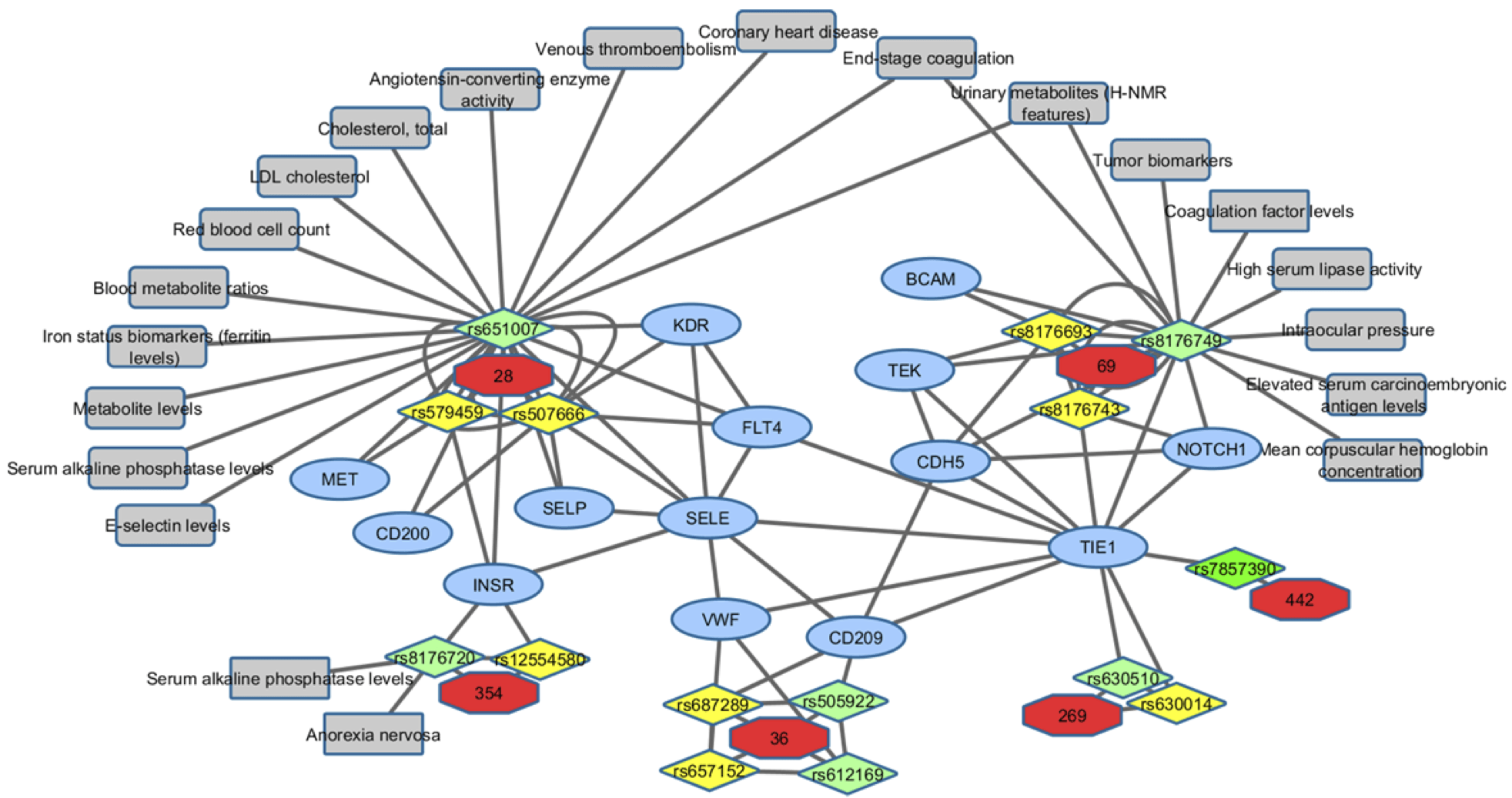Locus 28
Top associations per target
| Target | cis/trans | Study | SNP | SNP location | Maj/min allele | MAF | N | βinv | seinv | Pinv | fclog | Plog | Praw |
|---|---|---|---|---|---|---|---|---|---|---|---|---|---|
| sE-Selectin | trans | Discovery | rs651007 | 9:136,153,875 | C/T | 0.23 | 997 | -0.944 | 0.040 | 1.2×10-96 | -1.400 | 7.2×10-108 | 3×10-90 |
| sE-Selectin | trans | Replication | rs507666 | 9:136,149,399 | G/A | 0.16 | 337 | -0.823 | 0.077 | 8.2×10-23 | -1.400 | 8×10-24 | 5.2×10-15 |
| IR | trans | Discovery | rs651007 | 9:136,153,875 | C/T | 0.23 | 997 | -0.696 | 0.047 | 3.9×10-44 | -1.180 | 6.3×10-41 | 1.8×10-28 |
| IR | trans | Replication | rs579459 | 9:136,154,168 | A/G | 0.17 | 337 | -0.558 | 0.068 | 5.2×10-15 | -1.220 | 1.1×10-15 | 2.2×10-12 |
| VEGF sR3 | trans | Discovery | rs651007 | 9:136,153,875 | C/T | 0.23 | 997 | -0.593 | 0.049 | 1.1×10-31 | -1.150 | 2.3×10-33 | 2.4×10-31 |
| VEGF sR3 | trans | Replication | rs507666 | 9:136,149,399 | G/A | 0.16 | 337 | -0.472 | 0.081 | 1.4×10-8 | -1.140 | 8×10-10 | 2.6×10-8 |
| CD36 ANTIGEN | trans | Discovery | rs651007 | 9:136,153,875 | C/T | 0.23 | 997 | -0.535 | 0.046 | 1.3×10-29 | -1.160 | 1.4×10-29 | 5.2×10-27 |
| CD36 ANTIGEN | trans | Replication | rs507666 | 9:136,149,399 | G/A | 0.16 | 337 | -0.168 | 0.093 | 0.072 | -1.030 | 0.615 | 0.187 |
| Endoglin | cis | Discovery | rs651007 | 9:136,153,875 | C/T | 0.23 | 997 | -0.536 | 0.049 | 6×10-26 | -1.110 | 2.6×10-24 | 1.9×10-21 |
| Endoglin | cis | Replication | rs507666 | 9:136,149,399 | G/A | 0.16 | 337 | -0.207 | 0.073 | 0.005 | -1.070 | 0.016 | 0.136 |
| Met | trans | Discovery | rs651007 | 9:136,153,875 | C/T | 0.23 | 997 | -0.437 | 0.048 | 3.3×10-19 | -1.080 | 2.2×10-19 | 1.8×10-18 |
| Met | trans | Replication | rs579459 | 9:136,154,168 | A/G | 0.17 | 337 | -0.476 | 0.076 | 1.2×10-9 | -1.100 | 4.5×10-9 | 1×10-8 |
| sICAM-2 | trans | Discovery | rs651007 | 9:136,153,875 | C/T | 0.23 | 997 | -0.402 | 0.051 | 7.5×10-15 | -1.050 | 8×10-6 | 0.308 |
| sICAM-2 | trans | Replication | rs579459 | 9:136,154,168 | A/G | 0.17 | 337 | -0.184 | 0.071 | 0.01 | -1.010 | 0.578 | 0.407 |
| VEGF sR2 | trans | Discovery | rs651007 | 9:136,153,875 | C/T | 0.23 | 997 | -0.367 | 0.050 | 3.1×10-13 | -1.060 | 4.4×10-13 | 6.8×10-13 |
| VEGF sR2 | trans | Replication | rs507666 | 9:136,149,399 | G/A | 0.16 | 337 | -0.346 | 0.080 | 1.9×10-5 | -1.070 | 4.8×10-5 | 6×10-5 |
| ST4S6 | trans | Discovery | rs651007 | 9:136,153,875 | C/T | 0.23 | 997 | -0.365 | 0.050 | 6.7×10-13 | -1.060 | 6.2×10-12 | 3.5×10-10 |
| ST4S6 | trans | Replication | rs507666 | 9:136,149,399 | G/A | 0.16 | 337 | -0.052 | 0.067 | 0.44 | -1.000 | 0.826 | 0.272 |
| P-Selectin | trans | Discovery | rs651007 | 9:136,153,875 | C/T | 0.23 | 997 | -0.373 | 0.051 | 7.4×10-13 | -1.070 | 2.5×10-11 | 7.6×10-12 |
| P-Selectin | trans | Replication | rs507666 | 9:136,149,399 | G/A | 0.16 | 337 | -0.262 | 0.055 | 3.4×10-6 | -1.090 | 9×10-6 | 0.001 |
| TLR4:MD-2 complex | trans | Discovery | rs651007 | 9:136,153,875 | C/T | 0.23 | 997 | -0.364 | 0.052 | 3.4×10-12 | -1.080 | 2.7×10-11 | 1.7×10-8 |
| TLR4:MD-2 complex | trans | Replication | rs507666 | 9:136,149,399 | G/A | 0.16 | 337 | -0.189 | 0.068 | 0.006 | -1.050 | 0.017 | 0.059 |
| Cadherin-5 | trans | Discovery | rs651007 | 9:136,153,875 | C/T | 0.23 | 997 | -0.359 | 0.051 | 4.8×10-12 | -1.070 | 3.6×10-11 | 3.7×10-9 |
| Cadherin-5 | trans | Replication | rs507666 | 9:136,149,399 | G/A | 0.16 | 337 | -0.257 | 0.077 | 0.001 | -1.060 | 0.001 | 0.001 |
| JAG1 | trans | Discovery | rs651007 | 9:136,153,875 | C/T | 0.23 | 997 | -0.336 | 0.050 | 4.7×10-11 | -1.040 | 3.9×10-11 | 1.7×10-10 |
| JAG1 | trans | Replication | rs579459 | 9:136,154,168 | A/G | 0.17 | 337 | -0.192 | 0.066 | 0.004 | -1.020 | 0.082 | 0.457 |
| OX2G | trans | Discovery | rs651007 | 9:136,153,875 | C/T | 0.23 | 997 | -0.328 | 0.050 | 8×10-11 | -1.050 | 1.7×10-5 | 0.116 |
| OX2G | trans | Replication | rs507666 | 9:136,149,399 | G/A | 0.16 | 337 | -0.348 | 0.077 | 8.2×10-6 | -1.060 | 0.034 | 0.458 |
| CD109 | trans | Discovery | rs651007 | 9:136,153,875 | C/T | 0.23 | 997 | -0.300 | 0.052 | 8.4×10-9 | -1.070 | 1.5×10-8 | 1.2×10-7 |
| CD109 | trans | Replication | rs507666 | 9:136,149,399 | G/A | 0.16 | 337 | -0.151 | 0.075 | 0.044 | -1.060 | 0.072 | 0.061 |
Regional association plots
E-Selectin (sE-Selectin)
Insulin receptor (IR)
Vascular endothelial growth factor receptor 3 (VEGF sR3)
Platelet glycoprotein 4 (CD36 ANTIGEN)
Endoglin
Hepatocyte growth factor receptor (Met)
Intercellular adhesion molecule 2 (sICAM-2)
Vascular endothelial growth factor receptor 2 (VEGF sR2)
Carbohydrate sulfotransferase 15 (ST4S6)
P-Selectin
Toll-like receptor 4:Lymphocyte antigen 96 complex (TLR4:MD-2 complex)
Cadherin-5
Protein jagged-1 (JAG1)
OX-2 membrane glycoprotein (OX2G)
CD109 antigen (CD109)
Boxplots and histograms for top associations
E-Selectin (sE-Selectin)
| inverse-normalized probe levels | log2 transformed probe levels | raw probe levels | |
|---|---|---|---|
| Discovery study |


|


|


|
| Replication study |


|


|


|
Insulin receptor (IR)
| inverse-normalized probe levels | log2 transformed probe levels | raw probe levels | |
|---|---|---|---|
| Discovery study |


|


|


|
| Replication study |


|


|


|
Vascular endothelial growth factor receptor 3 (VEGF sR3)
| inverse-normalized probe levels | log2 transformed probe levels | raw probe levels | |
|---|---|---|---|
| Discovery study |


|


|


|
| Replication study |


|


|


|
Platelet glycoprotein 4 (CD36 ANTIGEN)
| inverse-normalized probe levels | log2 transformed probe levels | raw probe levels | |
|---|---|---|---|
| Discovery study |


|


|


|
| Replication study |


|


|


|
Endoglin
| inverse-normalized probe levels | log2 transformed probe levels | raw probe levels | |
|---|---|---|---|
| Discovery study |


|


|


|
| Replication study |


|


|


|
Hepatocyte growth factor receptor (Met)
| inverse-normalized probe levels | log2 transformed probe levels | raw probe levels | |
|---|---|---|---|
| Discovery study |


|


|


|
| Replication study |


|


|


|
Intercellular adhesion molecule 2 (sICAM-2)
| inverse-normalized probe levels | log2 transformed probe levels | raw probe levels | |
|---|---|---|---|
| Discovery study |


|


|


|
| Replication study |


|


|


|
Vascular endothelial growth factor receptor 2 (VEGF sR2)
| inverse-normalized probe levels | log2 transformed probe levels | raw probe levels | |
|---|---|---|---|
| Discovery study |


|


|


|
| Replication study |


|


|


|
Carbohydrate sulfotransferase 15 (ST4S6)
| inverse-normalized probe levels | log2 transformed probe levels | raw probe levels | |
|---|---|---|---|
| Discovery study |


|


|


|
| Replication study |


|


|


|
P-Selectin
| inverse-normalized probe levels | log2 transformed probe levels | raw probe levels | |
|---|---|---|---|
| Discovery study |


|


|


|
| Replication study |


|


|


|
Toll-like receptor 4:Lymphocyte antigen 96 complex (TLR4:MD-2 complex)
| inverse-normalized probe levels | log2 transformed probe levels | raw probe levels | |
|---|---|---|---|
| Discovery study |


|


|


|
| Replication study |


|


|


|
Cadherin-5
| inverse-normalized probe levels | log2 transformed probe levels | raw probe levels | |
|---|---|---|---|
| Discovery study |


|


|


|
| Replication study |


|


|


|
Protein jagged-1 (JAG1)
| inverse-normalized probe levels | log2 transformed probe levels | raw probe levels | |
|---|---|---|---|
| Discovery study |


|


|


|
| Replication study |


|


|


|
OX-2 membrane glycoprotein (OX2G)
| inverse-normalized probe levels | log2 transformed probe levels | raw probe levels | |
|---|---|---|---|
| Discovery study |


|


|


|
| Replication study |


|


|


|
CD109 antigen (CD109)
E-Selectin (sE-Selectin)
| Target (abbrv.) | sE-Selectin |
| Target (full name) | E-Selectin |
| Somalogic ID (Sequence ID) | SL001945 (3470-1_2) |
| Entrez Gene Symbol | SELE |
| UniProt ID | P16581 |
| UniProt Comment |
|
| Biomarker applications (based on IPA annotation) |
|
| Pathway Interaction Database |
|
| Reactome |
|
| Pathway Studio |
|
Insulin receptor (IR)
| Target (abbrv.) | IR |
| Target (full name) | Insulin receptor |
| Somalogic ID (Sequence ID) | SL004125 (3448-13_2) |
| Entrez Gene Symbol | INSR |
| UniProt ID | P06213 |
| UniProt Comment |
|
| Targeted by drugs (based on IPA annotation) |
|
| Biomarker applications (based on IPA annotation) |
|
| Wiki Pathways |
|
| Pathway Interaction Database |
|
| Reactome |
|
| Pathway Studio |
|
Vascular endothelial growth factor receptor 3 (VEGF sR3)
| Target (abbrv.) | VEGF sR3 |
| Target (full name) | Vascular endothelial growth factor receptor 3 |
| Somalogic ID (Sequence ID) | SL003322 (2358-19_2) |
| Entrez Gene Symbol | FLT4 |
| UniProt ID | P35916 |
| UniProt Comment |
|
| Targeted by drugs (based on IPA annotation) |
|
| Biomarker applications (based on IPA annotation) |
|
| Pathway Interaction Database |
|
| Reactome |
|
| Pathway Studio |
|
Platelet glycoprotein 4 (CD36 ANTIGEN)
| Target (abbrv.) | CD36 ANTIGEN |
| Target (full name) | Platelet glycoprotein 4 |
| Somalogic ID (Sequence ID) | SL000668 (2973-15_2) |
| Entrez Gene Symbol | CD36 |
| UniProt ID | P16671 |
| UniProt Comment |
|
| Biomarker applications (based on IPA annotation) |
|
| Wiki Pathways |
|
| Reactome |
|
Endoglin
| Target (abbrv.) | Endoglin |
| Target (full name) | Endoglin |
| Somalogic ID (Sequence ID) | SL004482 (4908-6_1) |
| Entrez Gene Symbol | ENG |
| UniProt ID | P17813 |
| UniProt Comment |
|
| Biomarker applications (based on IPA annotation) |
|
| Wiki Pathways |
|
| Pathway Interaction Database |
|
Hepatocyte growth factor receptor (Met)
| Target (abbrv.) | Met |
| Target (full name) | Hepatocyte growth factor receptor |
| Somalogic ID (Sequence ID) | SL000134 (2837-3_2) |
| Entrez Gene Symbol | MET |
| UniProt ID | P08581 |
| UniProt Comment |
|
| Targeted by drugs (based on IPA annotation) |
|
| Biomarker applications (based on IPA annotation) |
|
| Wiki Pathways |
|
| Pathway Interaction Database |
|
| Reactome |
|
| Pathway Studio |
|
Intercellular adhesion molecule 2 (sICAM-2)
| Target (abbrv.) | sICAM-2 |
| Target (full name) | Intercellular adhesion molecule 2 |
| Somalogic ID (Sequence ID) | SL003177 (2842-68_1) |
| Entrez Gene Symbol | ICAM2 |
| UniProt ID | P13598 |
| UniProt Comment |
|
Vascular endothelial growth factor receptor 2 (VEGF sR2)
| Target (abbrv.) | VEGF sR2 |
| Target (full name) | Vascular endothelial growth factor receptor 2 |
| Somalogic ID (Sequence ID) | SL003201 (3651-50_5) |
| Entrez Gene Symbol | KDR |
| UniProt ID | P35968 |
| UniProt Comment |
|
| Targeted by drugs (based on IPA annotation) |
|
| Biomarker applications (based on IPA annotation) |
|
| Wiki Pathways |
|
| Pathway Interaction Database |
|
| Reactome |
|
| Pathway Studio |
|
Carbohydrate sulfotransferase 15 (ST4S6)
| Target (abbrv.) | ST4S6 |
| Target (full name) | Carbohydrate sulfotransferase 15 |
| Somalogic ID (Sequence ID) | SL007502 (4469-78_2) |
| Entrez Gene Symbol | CHST15 |
| UniProt ID | Q7LFX5 |
| UniProt Comment |
|
| Reactome |
|
P-Selectin
| Target (abbrv.) | P-Selectin |
| Target (full name) | P-Selectin |
| Somalogic ID (Sequence ID) | SL000560 (4154-57_2) |
| Entrez Gene Symbol | SELP |
| UniProt ID | P16109 |
| UniProt Comment |
|
| Biomarker applications (based on IPA annotation) |
|
| Pathway Interaction Database |
|
| Reactome |
|
| Pathway Studio |
|
Toll-like receptor 4:Lymphocyte antigen 96 complex (TLR4:MD-2 complex)
| Target (abbrv.) | TLR4:MD-2 complex |
| Target (full name) | Toll-like receptor 4:Lymphocyte antigen 96 complex |
| Somalogic ID (Sequence ID) | SL018625 (3647-49_4) |
| Entrez Gene Symbol | TLR4, LY96 |
| UniProt ID | O00206, Q9Y6Y9 |
| UniProt Comment |
|
| Wiki Pathways |
|
| Pathway Interaction Database |
|
| Reactome |
|
| Pathway Studio |
|
Cadherin-5
| Target (abbrv.) | Cadherin-5 |
| Target (full name) | Cadherin-5 |
| Somalogic ID (Sequence ID) | SL002081 (2819-23_2) |
| Entrez Gene Symbol | CDH5 |
| UniProt ID | P33151 |
| UniProt Comment |
|
| Biomarker applications (based on IPA annotation) |
|
| Pathway Interaction Database |
|
| Reactome |
|
| Pathway Studio |
|
Protein jagged-1 (JAG1)
| Target (abbrv.) | JAG1 |
| Target (full name) | Protein jagged-1 |
| Somalogic ID (Sequence ID) | SL007328 (5092-51_3) |
| Entrez Gene Symbol | JAG1 |
| UniProt ID | P78504 |
| UniProt Comment |
|
| Biomarker applications (based on IPA annotation) |
|
| Wiki Pathways |
|
| Pathway Interaction Database |
|
| Reactome |
|
| Pathway Studio |
|
OX-2 membrane glycoprotein (OX2G)
| Target (abbrv.) | OX2G |
| Target (full name) | OX-2 membrane glycoprotein |
| Somalogic ID (Sequence ID) | SL014268 (5112-73_3) |
| Entrez Gene Symbol | CD200 |
| UniProt ID | P41217 |
| UniProt Comment |
|
| Reactome |
|
CD109 antigen (CD109)
All locus annotations are based on the sentinel SNP (rs651007) and 9 proxy variant(s) that is/are in linkage disequilibrium r2 ≥ 0.8. Linkage disequilibrium is based on data from the 1000 Genomes Project, phase 3 version 5, European population and was retrieved using SNiPA's Block Annotation feature.
Download the detailed results of SNiPA's block annotation (PDF)
Linked genes
| Genes hit or close-by |
|
| Potentially regulated genes | |
| eQTL genes |
Results from other genome-wide association studies
| Trait | P | Study | Source |
|---|---|---|---|
| von Willebrand factor (vWF) | 1.4×10-161 | 21534939 (PMID) | GRASP2 nonQTL |
| Alkaline phosphatase (ALP) in plasma | 2.6×10-123 | 22001757 (PMID) | GRASP2 nonQTL |
| Liver enzyme levels (alkaline phosphatase) | 3×10-123 | 22001757 (PMID) | GWAS Catalog via SNiPA |
| E-selectin levels | 2×10-82 | 20147318 (PMID) | GWAS Catalog via SNiPA |
| Blood soluble E-selectin levels (female) | 2.4×10-82 | 20147318 (PMID) | GRASP2 nonQTL |
| Activated partial thromboplastin time | 4.7×10-75 | 22703881 (PMID) | GRASP2 nonQTL |
| Alkaline phosphatase (ALP) | 4.2×10-59 | 20139978 (PMID) | GRASP2 nonQTL |
| Serum alkaline phosphatase levels | 1×10-56 | 24094242 (PMID) | GWAS Catalog via SNiPA |
| LDL cholesterol | 2.4×10-44 | 24097068 (PMID) | Supplemental file |
| Triglycerides | 8.8×10-42 | 24097068 (PMID) | Supplemental file |
| Soluble P-selectin | 1.9×10-41 | 20167578 (PMID) | GRASP2 nonQTL |
| Soluble levels of adhesion molecules | 2×10-41 | 20167578 (PMID) | GWAS Catalog via SNiPA |
| Blood metabolite ratios | 6×10-34 | 24816252 (PMID) | GWAS Catalog via SNiPA |
| Soluble E-selectin levels | 1×10-29 | 19729612 (PMID) | GWAS Catalog via SNiPA |
| cg18718102 (chr9:136203313) | 1.3×10-29 | 10.1101/033084 (DOI) | BIOS QTL cis-meQTLs |
| Serum soluble E-selectin | 1.3×10-29 | 19729612 (PMID) | GRASP2 nonQTL |
| E-selectin | 1.3×10-29 | pha002871 (dbGaP) | dbGaP via SNiPA |
| Venous thrombosis | 5.6×10-29 | 22675575 (PMID) | GRASP2 nonQTL |
| Urinary metabolites (H-NMR features) | 1×10-28 | 24586186 (PMID) | GWAS Catalog via SNiPA |
| Blood soluble E-selectin levels (in non-diabetic females) | 7.6×10-26 | 20147318 (PMID) | GRASP2 nonQTL |
| Factor XIII antigen | 1.9×10-25 | 23381943 (PMID) | GRASP2 nonQTL |
| End-stage coagulation | 2×10-25 | 23381943 (PMID) | GWAS Catalog via SNiPA |
| Total cholesterol | 1×10-21 | 20686565 (PMID) | GRASP2 nonQTL |
| Plasma carcinoembryonic antigen (CEA) levels | 1.8×10-21 | 23300138 (PMID) | GRASP2 nonQTL |
| Cholesterol, total | 9×10-21 | 20686565 (PMID) | GWAS Catalog via SNiPA |
| Blood soluble E-selectin levels (in diabetic females) | 1.5×10-20 | 20147318 (PMID) | GRASP2 nonQTL |
| Blood metabolite levels | 6×10-20 | 24816252 (PMID) | GWAS Catalog via SNiPA |
| ADpSGEGDFXAEGGGVR* | 6.3×10-20 | 24816252 (PMID) | gwas.eu via SNiPA |
| Red blood cell traits | 9×10-18 | 23222517 (PMID) | GWAS Catalog via SNiPA |
| Red blood cell count (RBC) | 9.3×10-18 | 23222517 (PMID) | GRASP2 nonQTL |
| Venous thromboembolism | 1.2×10-17 | 22672568 (PMID) | GRASP2 nonQTL |
| Hemoglobin (Hb) | 1.4×10-15 | 23222517 (PMID) | GRASP2 nonQTL |
| Coronary heart disease | 4×10-14 | 21378990 (PMID) | GWAS Catalog via SNiPA |
| Coronary artery disease (CAD) | 4.1×10-14 | 23364394 (PMID) | GRASP2 nonQTL |
| Hematocrit (Hct) | 7.6×10-14 | 23222517 (PMID) | GRASP2 nonQTL |
| Angiotensin-converting enzyme (ACE) activity | 2×10-13 | 20066004 (PMID) | GRASP2 nonQTL |
| cg14560040 (chr9:136203329) | 3×10-13 | 10.1101/033084 (DOI) | BIOS QTL cis-meQTLs |
| Interleukin-6 (IL-6) levels | 3.6×10-13 | 22291609 (PMID) | GRASP2 nonQTL |
| Red blood cell count | 3×10-12 | 20139978 (PMID) | GWAS Catalog via SNiPA |
| Hematological and biochemical traits | 1×10-11 | 20139978 (PMID) | GWAS Catalog via SNiPA |
| Serum metabolite (mass spec peak: 512.2 m/z) | 4.1×10-11 | 23281178 (PMID) | GRASP2 metabQTL |
| Circulating galectin-3 levels | 1.9×10-10 | 23056639 (PMID) | GRASP2 nonQTL |
| Serum metabolite (mass spec peak: 765.4 m/z) | 2.9×10-10 | 23281178 (PMID) | GRASP2 metabQTL |
| cg13040392 (chr9:136075369) | 1.5×10-9 | 10.1101/033084 (DOI) | BIOS QTL cis-meQTLs |
| Coronary artery disease or ischemic stroke | 2×10-9 | 24262325 (PMID) | GWAS Catalog via SNiPA |
| Metabolite levels | 6×10-9 | 21909109 (PMID) | GWAS Catalog via SNiPA |
| Iron status biomarkers (ferritin levels) | 1×10-8 | 25352340 (PMID) | GWAS Catalog via SNiPA |
| Coronary artery disease (CAD) (males) | 2.8×10-8 | 23202125 (PMID) | GRASP2 nonQTL |
| Angiotensin-converting enzyme activity | 3×10-8 | 20066004 (PMID) | GWAS Catalog via SNiPA |
| Coronary artery disease or large artery stroke | 3×10-8 | 24262325 (PMID) | GWAS Catalog via SNiPA |
| Coronary artery disease and myocardial infarction | 7.1×10-8 | 23202125 (PMID) | Supplemental file |
| Fasting serum interleukin-6 (IL-6) (pg/mL) in children | 1.7×10-7 | 23251661 (PMID) | GRASP2 nonQTL |
| Coronary Artery Disease | 2×10-7 | 24262325 (PMID) | GWAS Catalog via SNiPA |
| Coronary artery disease (CAD) with myocardial infarction (MI) | 2.2×10-7 | 23202125 (PMID) | GRASP2 nonQTL |
| Coronary artery disease (CAD) (men) | 2.6×10-7 | 21378990 (PMID) | GRASP2 nonQTL |
| Myocardial infarction (MI) | 5.2×10-7 | 21378990 (PMID) | GRASP2 nonQTL |
| Pancreatic cancer | 8.2×10-7 | 19648918 (PMID) | GRASP2 nonQTL |
| Gene expression of ABO (probeID ILMN_1656979) in cerebellum in non-Alzheimer's disease samples | 2.9×10-6 | 22685416 (PMID) | GRASP2 eQTL |
| Gene expression of ABO in lymphoblastoid cell lines | 4.5×10-6 | 21378990 (PMID) | GRASP2 nonQTL |
| Gene expression of ABO (probeID ILMN_1656979) in cerebellum in Alzheimer's disease cases and controls | 5.3×10-6 | 22685416 (PMID) | GRASP2 eQTL |
| Gamma-glutamyl transferase (GGT) | 2.4×10-5 | 22001757 (PMID) | GRASP2 nonQTL |
| Fasting glucose | 3.3×10-5 | 22885924 (PMID) | Supplemental file |
| Gene expression of SURF1 in blood | 9.9×10-5 | 21829388 (PMID) | GRASP2 eQTL |
| Coronary artery disease (CAD) age <=50 | 1.2×10-4 | 23202125 (PMID) | GRASP2 nonQTL |
| Gene expression of SURF6 in blood | 1.8×10-4 | 21829388 (PMID) | GRASP2 eQTL |
| Coronary artery disease (CAD) with age of onset <=50 | 2×10-4 | 21378990 (PMID) | GRASP2 nonQTL |
| 2h glucose | 2.1×10-4 | 22885924 (PMID) | Supplemental file |
| Coronary artery disease (CAD) age >50 | 2.2×10-4 | 23202125 (PMID) | GRASP2 nonQTL |
| Adiponectin levels | 2.4×10-4 | 22479202 (PMID) | GRASP2 nonQTL |
| Schizophrenia | 3.7×10-4 | 19571809 (PMID) | GRASP2 nonQTL |
The pleiotropic ABO locus is discussed in the main paper.
This locus is discussed in the main paper. Here we report observations not mentioned in the paper: In Shin et al. [PubMed] SNP rs651007 associates with dipeptide levels (aspartylphenylalanine, p=2×10-7; X-14189, annotated as potential Leu-Ala, but Ser-Pro is also possible by mass alone, p=9.6×10-10; X14304, I/L-Ala or Ala-I/L?, p=1.8×10-8; X-14208, could be Cys-Met or Tyr-Ala or His-Pro or Ser-Phe by mass alone, p=1.5×10-7; X-14205; X14086: annotated as Thr-Glu, but mass is 25 too high; Val-Arg possible by mass alone). This SNP also associates in Raffler et al. [PubMed] (Urine NMR) with a signal at 2.0308 ppm (PM20308, p=5.1×10-20). It is also a marginal hit in CardioGram (7.1×10-8). He et al. [PubMed] report a genome wide association study of genetic loci that influence tumour biomarkers cancer antigen 19-9, carcinoembryonic antigen and α fetoprotein and their associations with cancer risk. The authors find strong association of SNP rs8176749 with carcinoembryonic antigen (CEA) levels – we find association with Cadherin-5. CD209 and MBL2 are both lectins. All associated ABO-associated proteins are glycoproteins, part of glycoprotein complex (LY96), or glycoprotein-binding (SELE), except for IL27RA (http://jcggdb.jp/rcmg/gpdb/index). According to Uniprot all proteins are glycoproteins (including associations non-replicated in QMDiab), while only half of all SomaLogic proteins are glycoproteins. The Panther classification system (http://pantherdb.org/tools/compareToRefList.jsp) reported a significant enrichment of the GO process "endothelial cell differentiation" (GO:0045446): 5 out of 17 annotated proteins were found (expected were 0.32, p=1.45×10-5). 
Subnetwork of the ABO locus.Six replicated pQTLs at the ABO gene locus (red), including SNP identifiers that are linked to the the six loci (light green KORA SNPs, yellow QMDiab SNPs, bright green both), pQTLS (blue), proteins with significant partial correlation are connected, associations with GWAS endpoints are shown (grey) [NOTE: the anorexia is a false positive, checked this with the consortium].
The information gathered here is a result of an attempt to keep track of all interesting information that we encountered while investigating these loci. Please bear in mind that the annotation given here is neither complete nor free of errors, and that all information provided here should be confirmed by additional literature research before being used as a basis for firm conclusions or further experiments.




























